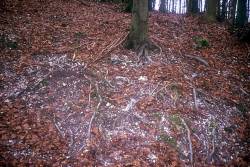 Soil consists of particles capable of moving past each other and allowing larger scale migration, especially on slopes. The shear strength is a function of the friction created between adjacent particles that results in a resistance to such gravitational movements. A wet soil will have an increased volume that expands the spaces between particles thus reducing their friction and the soil shear strength.
Soil consists of particles capable of moving past each other and allowing larger scale migration, especially on slopes. The shear strength is a function of the friction created between adjacent particles that results in a resistance to such gravitational movements. A wet soil will have an increased volume that expands the spaces between particles thus reducing their friction and the soil shear strength.
The presence of roots significantly increases the resistance of soil to shearing by providing a lattice to support it. If trees are managed to reduce the risk of windthrow and associated archaeological damage, for example by coppicing, they can help to maintain the form of an earthwork. Tree removal and subsequent root death on a sloping site can increase the risk of soil erosion, creating problems in establishing an alternative vegetation cover. The removal of trees from raised earthworks such as banks or burial mounds can have an adverse effect on the stability of the remaining soil.
Where heavy machinery is used, the soil is at risk from compaction and erosion unless suitably protected. On some sites, erosion rates may increase in the short term following harvesting operations until a protective vegetation layer has reestablished. Any archaeological evidence at or close to the soil surface could be at risk of damage or displacement during such operations. However, much of this erosion is preventable with appropriate soil protection and the use of brash mats is now common practice during harvesting. These mats significantly reduce the compaction and rutting by distributing the load over a larger area of soil and should reduce the risks to any archaeological evidence present.
Ironically, it is arguable that the soil conditions resulting from compaction, (with impeded root penetration, reduced aeration and drainage), may create conditions that favour the preservation of any deeper buried archaeological remains. However, these properties would also inhibit vegetation establishment, leaving a bare soil susceptible to erosion.